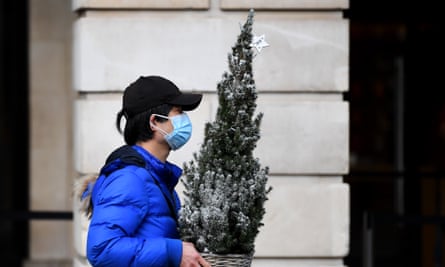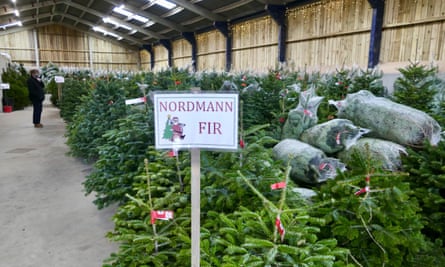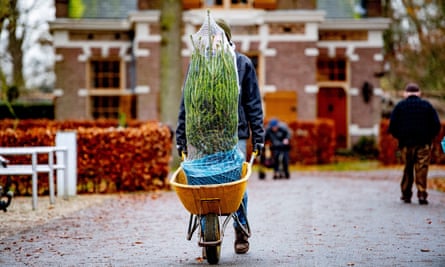Christmas trees: how the costs of real, fake and potted stack up
It will be a Christmas quite unlike any other this year. Yet putting up and decorating the Christmas tree remains one of our most treasured festive rituals and in the quest for “normality” we are buying them earlier than ever.
During the second lockdown, garden centres have been allowed to open and have enjoyed brisk business, while sales have soared for specialist “farmgate” sellers in England since the government last weekend relaxed restrictions and deemed them to be “essential” retailers.
The supermarket chain Waitrose is predicting this will be its biggest fresh Christmas tree launch weekend ever, with almost 40% of its shops taking all of their stock before 1 December to meet the expected demand.
 View image in fullscreenSales of Christmas trees are continuing despite the Covid lockdown in England. Photograph: James Veysey/Rex/Shutterstock
View image in fullscreenSales of Christmas trees are continuing despite the Covid lockdown in England. Photograph: James Veysey/Rex/Shutterstock
Oliver O’Mara, its Christmas tree buyer, says: “Shoppers are definitely getting into the Christmas spirit earlier than ever. Our biggest deliveries of real trees are usually in early December but we’ve brought some orders forward to meet expected demand.”
At John Lewis, fresh tree sales this week are almost three times (176%) more than the same time last year. For the first time, it is offering shoppers looking for an artificial tree a new “augmented reality” feature on its IOS app that will enable them to put up a decorated virtual Christmas tree in seconds. The feature will give customers the chance to try before they buy, putting an end to the traditional guessing game of hoping the tree will fit in the room.
From fake to fresh, how do the costs stack up?
Fresh
The “king”, and the most popular in the UK, is the Nordmann fir, with its lush, dark green bushy branches and fresh pine aroma. It also has a wide base to accommodate presents and has child-friendly soft needles that are slower to drop than a traditional Norway spruce.
According to Lee Chambers, the head of sales at Lovania Nurseries, a fresh Nordmann fir should last for up to a month provided you don’t let it dry out. “When you first take it home, cut a few inches off the base of the trunk and put it in a bucket of water overnight,” he advises. “Choose a cool spot with plenty of space, preferably away from radiators, as this can dry the needles prematurely.”
Typical cost: If price, rather than convenience, is your priority, you will need to shop around. The British Christmas Tree Growers Association urges shoppers to support local businesses. Its website, bctga.co.uk, will show you where to buy locally.
 View image in fullscreenNordmann firs at the the Tree Barn in Christmas Common, Oxfordshire. Photograph: Geoffrey Swaine/REX/Shutterstock
View image in fullscreenNordmann firs at the the Tree Barn in Christmas Common, Oxfordshire. Photograph: Geoffrey Swaine/REX/Shutterstock
Among the cheapest cut versions from big retailers are Aldi’s, which went on sale in its 895 UK stores this week, with prices starting at £14.99 for a medium tree (1.5m-1.75m/5-6ft) and £24.99 for a large tree (1.8m-2.1m/6-7ft). They are grown in Aberdeenshire for up to 10 years and for every tree that is cut down four are planted. B&Q’s cut Nordmanns are a little pricier at £19 for 1.2m–1.5m (4-5ft), £29 for 1.5m–1.75m (5-6ft) and £39 for 1.8m–2.1m (6-7ft). This year, for the first time, it is delivering. Standard delivery is £5 but free for orders over £50.
Ikea’s Christmas tree money-back offer is back for the ninth year. Launched last week at participating stores, customers can pick up a real Nordmann for £29 and receive a £20 Ikea voucher to spend in the new year.
It is worth checking the terms and conditions when you buy, although your rights are on a par with those of other perishable items such as fresh-cut flowers. If it perishes despite you following the instructions, and you can prove that it is not “fit for purpose” or “of satisfactory quality”, then under the Consumer Rights Act you should be entitled to an exchange or refund.
Depending on the height and weight, you may want to buy a metal stand to support it, with a built-in water reservoir. Don’t forget to top it up. Rustic-style wicker “skirts” are also popular but can be expensive.
Fake
 View image in fullscreenThe White Company’s fake tree range is pricey but looks like the real thing. Photograph: The White Company
View image in fullscreenThe White Company’s fake tree range is pricey but looks like the real thing. Photograph: The White Company
Artificial trees used to be a manky wire frame with a bit of tinsel attached but modern-day tree technology has leapt forward and uses injection moulding to create realistic sprigs. Even close up, the pricier artificial ones can fool most consumers into thinking they are real.
However, they are still plastic, creates high emissions to manufacture and transport, and will eventually end up in landfill (usually made from PVC, they are almost impossible to recycle). They need to be used for up to nine years to have less environmental impact than natural alternatives.
Typical cost: There are some good deals. Balsam Hill, for example, has a sale on its extensive range, offering, a 4ft (1.2m) unlit tree for £99, down from £159. There’s a 25% discount on artificial trees at Argos – many ideal for smaller spaces. Its slim 6ft tree, which usually costs £25, is a snip at £18.75. The White Company’s “show-stopping” 9ft fake Nordmann fir is at the luxury end with an £850 price tag.
Potted
Pot-grown trees are cute and ideal for small spaces but double check what you are buying. They are grown from seed in pots that are plunged into the ground, which, growers claim, provides a number of benefits. The plant is more stable and, due to specially designed holes in the pot, it stays cooler and has more consistent root temperatures. These are different from potted or “pot-pressed” trees in which the root system is pruned – often brutally – which lessens the chance of survival.
Typical cost: Aldi is home to the cheapest pot-grown Nordmann at £18.99. Waitrose has a “tabletop” version in a 16cm pot, on special offer for £19.99.
Rental
You can rent a tree for three weeks over the festive period – delivered to and collected from your home – which is a way to avoid the huge waste and the January Christmas tree “graveyards” littering City centres. It can also work out marginally cheaper than buying.
Typical cost: The typical charge is about £55 for three weeks, plus £20 deposit and £20 delivery/collection.
 View image in fullscreenOne sustainable option is to buy a tree that can be planted again when Christmas is over. Photograph: Robin Utrecht/Rex/Shutterstock
View image in fullscreenOne sustainable option is to buy a tree that can be planted again when Christmas is over. Photograph: Robin Utrecht/Rex/Shutterstock
Sustainable options?
Consumers who care about the environment can give their loved ones a real tree – one planted in a part of the world at risk of deforestation. Ecosia, the ethical search engine that uses advertising revenues to plant trees, has this week opened a pop-up store that gives shoppers a number of options from restoring volcano slopes in Nicaragua to planting fruit trees to alleviate hunger in India. The recipient will receive a certificate highlighting the cause and details of the trees bought.
Typical cost: Each tree costs £2 and can be purchased in bundles of five, 10, 20 or 40. Buyers will have a month before Christmas day to purchase. The buyer is given three product options: protecting wildlife habitats, tackling hunger or fighting climate change
Going organic
Christmas trees suffer from similar pest problems as many crops, so pesticide use is often high. Trees can’t technically be certified organic as the standards do not cover wood. It’s worth looking for Forest Stewardship Council (FSC) certified trees, as they’re grown in a responsibly managed way and often minimise pesticide use.
If possible, source from an organic independent retailer or farm shop, as they are more likely to opt for total avoidance of pesticides.


